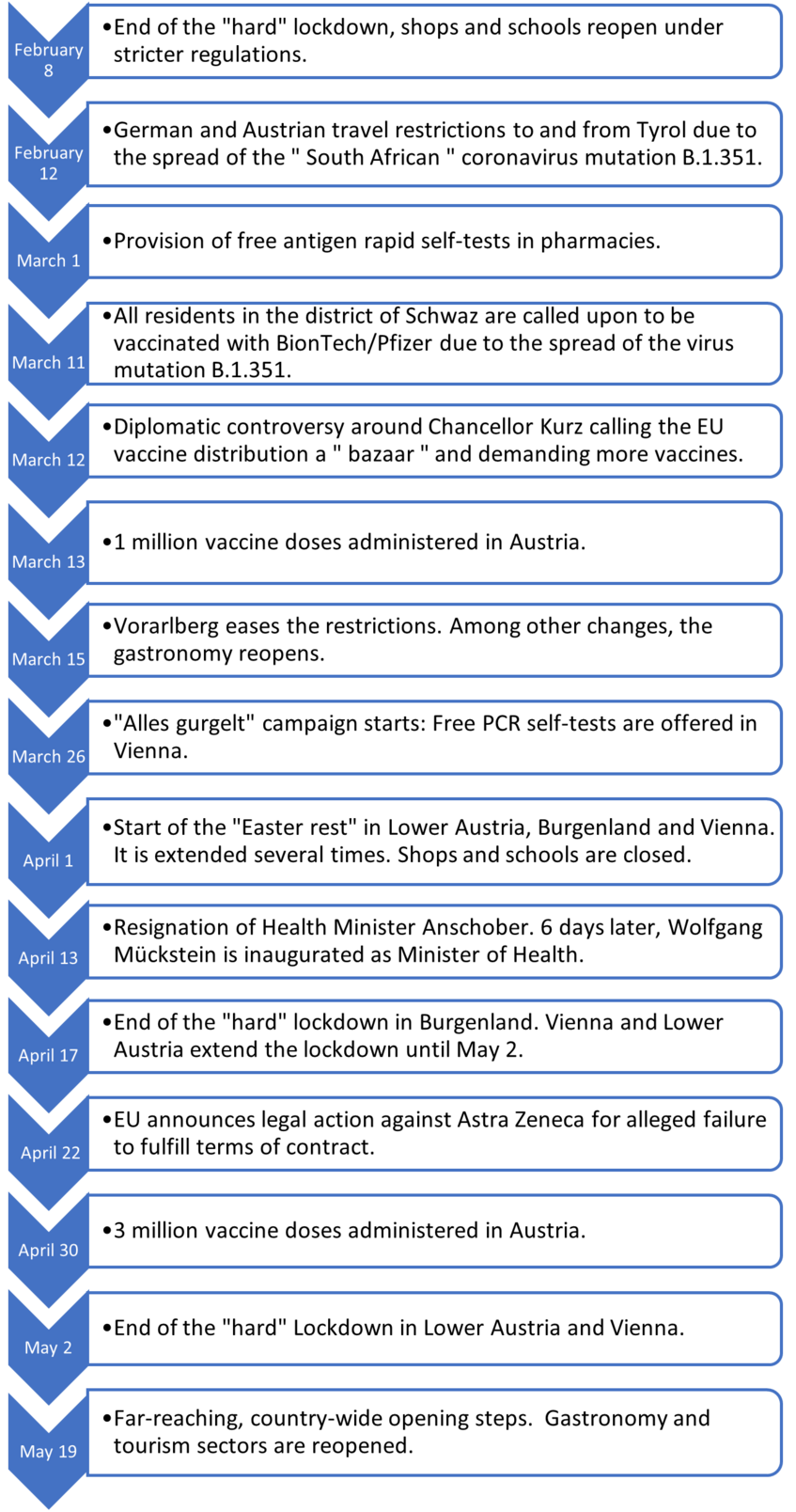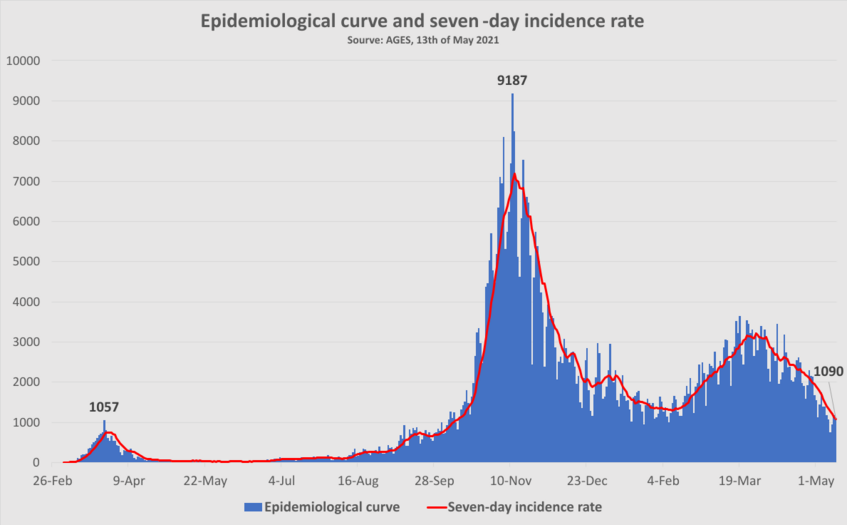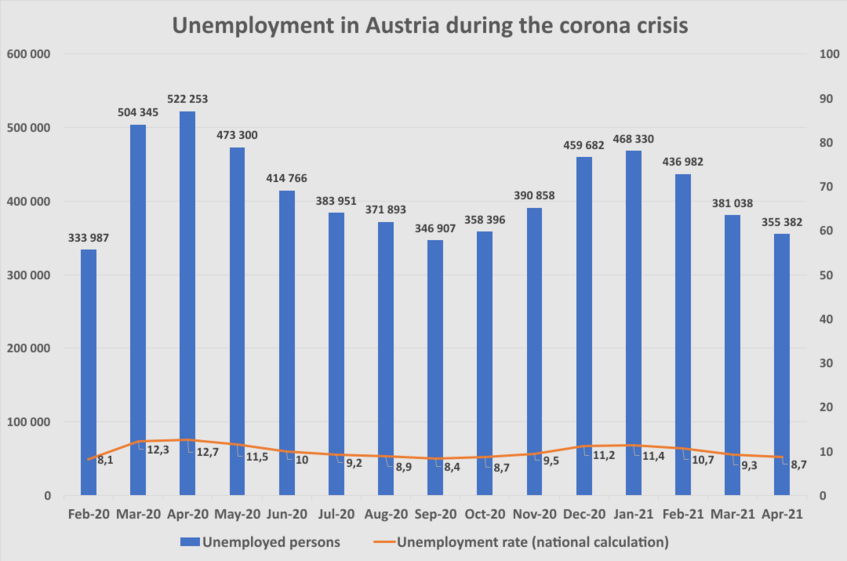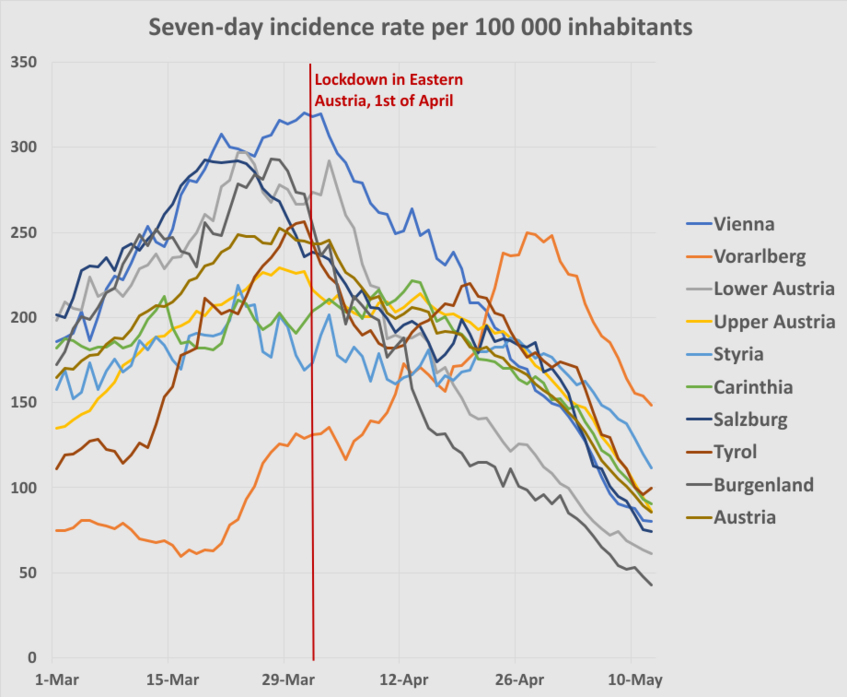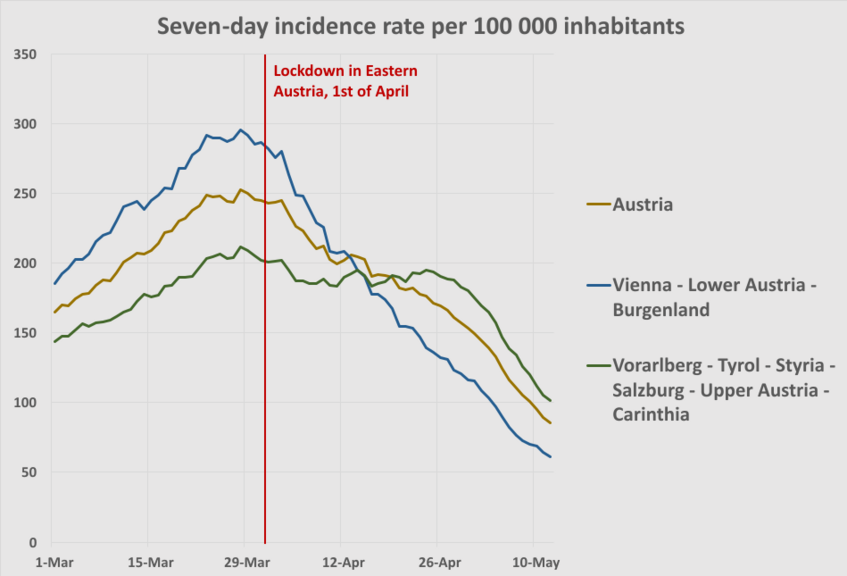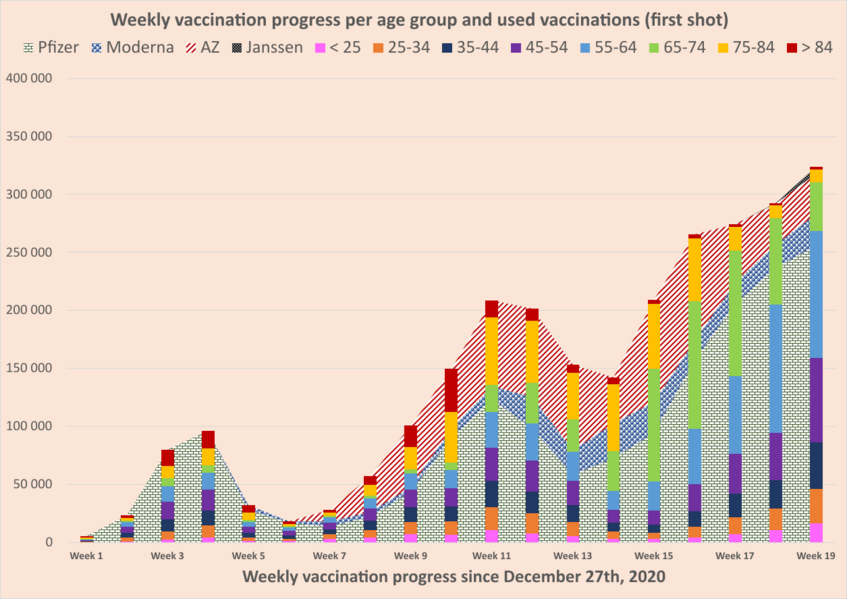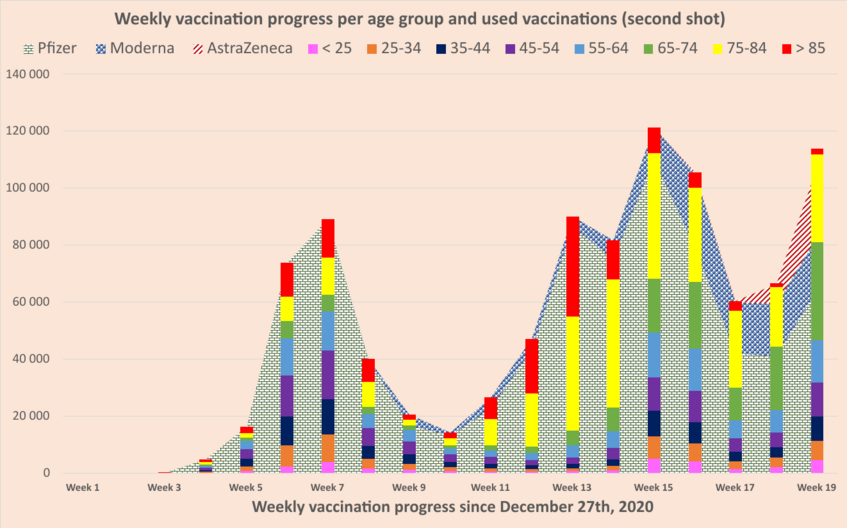28.05.2021 - PDF
Chronology of the Corona Crisis in Austria - Part 5: Third Wave, Regional Lockdowns and the Vaccination Campaign
- Following the openings on February 8, 2021, a third wave of infection hit Austria. However, infection rates increased much slower in February and March than during the second wave in autumn 2020. In view of an increasing number of infections, Vienna, Lower Austria, and Burgenland, after initial discussions about openings, introduced another "hard" lockdown starting on April 1. It lasted several weeks. Vorarlberg, on the other hand, eased numerous measures on March 15.
- In a regionalization of the crisis policy, the federal government was increasingly replaced by the state governors as decision-making bodies during the Corona crisis. Health Minister Rudolf Anschober resigned on April 13, 2021, for health reasons and was replaced by Wolfgang Mückstein six days later.
- The vaccination campaign has accelerated significantly since March, despite supply shortages. By May 28, 2021, about 46,5% of the vaccine-eligible population (16+) had received at least the first vaccination dose. Vaccines from BionTech/Pfizer accounted for about 7 out of 10 of these doses. In addition, testing capacities were further expanded and rapid antigen tests were offered free of charge in pharmacies. In Vienna, PCR tests were also offered free of charge.
- The unemployment rate in April 2021 (8.7%) remained slightly above the pre-crisis level in February 2020 (8.1%). However, it was significantly lower than during the first lockdown in April 2020 (12.7%).
By Markus Pollak, Nikolaus Kowarz and Julia Partheymüller
For more than a year, the Corona crisis has dominated public life in Austria. As part of our Corona Chronology, we have highlighted the various phases of the crisis and recorded the most important events:
From the background and the first lockdown (Chronology Part 1), to the restoration of normality in the following months (Chronology Part 2), the calm summer of 2020 and the beginning of the second wave of infection (Chronology Part 3), to the new lockdowns as well as the introduction of mass testing and the start of the vaccination campaign in the end of December 2020 (Chronology Part 4).
In this article, we describe the main events, the dynamics of infections, and the socio-economic development from February to May 2021.
February 2021: Openings and mutations
After an extended "hard" lockdown in December 2020 and January 2021, a number of measures ended on February 8, 2021, by a decree of the ministry of health. It lifted numerous restrictions, including all-day curfews, shop and school closures. Although the announced target of a 7-day incidence rate of less than 50 had been missed, the number of confirmed infections had previously been significantly reduced.
However, new virus mutations spread in Austria. Just four days after the end of the lockdown, on February 12, 2021, German authorities announced restrictions on border crossings from Tyrol and declared the province a "mutation area” (“Mutationsgebiet”). At the same time, a decree from the Austrian Ministry of Health restricted travels from Tyrol to other parts of Austria to stop the spread of virus mutations.
After the openings, infection numbers increased again according to AGES data [1], although the rapid rates of increase of the second wave in autumn were not reached (see Figure 2). At the same time, it was announced that the testing capacities would be massively increased. Finally, as of March 1, antigen rapid self-tests were made available free of charge in pharmacies throughout Austria.
March 2021: Testing, opening discussions, and the announcement of new lockdowns.
At the beginning of March, further opening steps were discussed in view of the measures that were still in place. The federal government and the conference of state governors announced on March 1 that outdoor catering (“Schanigärten”) would be opened on March 27. Vorarlberg, the state with the lowest infection numbers at that time, was supposed to go first and lift a number of restrictions in gastronomy, sports and culture on March 15. As a "model region," the state was to test the planned openings in other states. In this context, Chancellor Kurz reaffirmed the federal government's goal of "returning to normality by the summer." Openings in the cultural sector were announced for April. In the end, only the opening steps in Vorarlberg were executed, although initially numerous bars and restaurants did not open because they feared a loss of revenue as a result of the stricter measures.
On March 3, it was also announced that an EU contingent of 100,000 Biontech/Pfizer vaccine doses would be made available early due to the spread of the so-called "South African" virus variant (B.1.351) in the Tyrolean district of Schwaz. Vaccination began March 11 for all residents of Schwaz over the age of 16 and was scientifically monitored to assess the vaccine's effectiveness with new mutations. The spread of more aggressive virus mutations, including the "British" virus variant, and the reduced effectiveness of vaccines against new variants were increasingly discussed with regard to the further development of the crisis.
On March 26, the "Alles gurgelt" campaign was launched in Vienna, providing free PCR tests through supermarkets and drugstores. Shortly before this, a diplomatic controversy arose around Chancellor Kurz's criticism of a "bazaar" in connection with EU vaccine distribution. In this context, the Chancellor called for a partial redistribution of vaccines by the European Union (EU), for which he was criticized by his party colleague EU Commissioner Johannes Hahn.
The situation on the labor market has increasingly improved since the opening steps in February, according to data from the Public Employment Service Austria (AMS). While the unemployment rate was still at 11.4% in January 2021 according to the national calculation method, it fell to 9.3% by March. The development continued in April 2021 (see Figure 3).
April 2021: Eastern lockdowns and the resignation of the Minister of Health.
Finally, in March, the rapid increase in the number of infections left no doubt that Austria would be confronted with a third wave of infection. The new situation in March revealed major regional differences, as Vorarlberg, for instance, had a significantly lower incidence of infections than other states (see Figure 4) [2].
Given the regional differences, the end of March brought a change in Austria's crisis policy. Previously, even though the Corona traffic light was introduced, the focus had been mainly on nationwide measures. On this basis, the first and second waves were responded to with nationwide lockdowns. This time, however, in view of the worsening situation in March 2021, the focus lay on regional solutions in the individual states. The state governors thus assumed a leading role in the decision-making and communication processes during the crisis. On March 24, the governors of Lower Austria, Burgenland and Vienna announced a six-day "Easter rest" (“Osterruhe”) starting on April 1. It was a "hard lockdown" that included an all-day curfew and the closure of shops and schools.
However, two days before the start of the "Easter rest”, the period of validity of the measures in Vienna was already extended until April 11 - extensions in Lower Austria and Burgenland followed later. It did not remain the only extension. Lower Austria and Vienna extended the lockdown two more times on April 6 and April 12, until it finally ended on May 2. The schools, however, had already been opened a week earlier. Burgenland´s state government decided against the third extension of the lockdown and ended the "hard" lockdown already on April 18. The gastronomy and the cultural sector remained closed in all states except Vorarlberg.
After several days of sick leave and media speculation about his state of health, Minister Rudolf Anschober resigned for health reasons on April 13, 2021. Since the beginning of the crisis, he had been in charge of the health ministry, which is central to crisis management. Six days later, on April 19, Wolfgang Mückstein was inaugurated as the new Minister of Health.
Following numerous supply shortages caused by the vaccine manufacturer Astra Zeneca, which had a massive impact on the EU's vaccination strategy, the EU prepared a lawsuit against the pharmaceutical company at the end of March. According to the European Commission's legal opinion, the vaccine manufacturer had not fulfilled its contractual obligations. In addition, there had been discussions since March about possible side effects of Astra Zeneca's vaccine. Finally, in April, the European Medicines Agency (EMA) had confirmed an extremely rare link between the vaccine and thromboses.
May 2021: End of the Eastern Lockdown and the Acceleration of the Vaccination Campaign
Eventually, at the beginning of May, the "Eastern lockdown" was completely ended. Vienna and Lower Austria thus returned to the nationwide norm of a partial lockdown. Nighttime curfews, restaurant closures, and the closure of tourism thus remained in effect. However, schools, museums and shops apart from the basic supply all opened. Due to falling infection rates, the federal government most recently announced nationwide openings for May 19, 2021.
In addition, since March, the vaccination campaign has accelerated significantly (see Figure 5). By March 15, 2021 - more than two months into the campaign - one million vaccination doses had been administered (calendar week 11). About two months and two weeks later, on May 28, 2021, 4.865.100 vaccine doses had already been administered, according to the Ministry of Health, with approximately 2 million vaccine doses having been administered since the beginning of the month alone. Just under 46,5% of the vaccinatable population (16+) has thus received at least the first dose. 69.9% of vaccines administered have been provided by Biontech/Pfizer, while 20.3% have been supplied by Astra Zeneca and 9.5% by Moderna (as of May 12).
The prioritization of different groups of people proposed by the national vaccination board (Nationales Impfgremium) has been the subject of ongoing controversy during the vaccination campaign. Figure 5 shows the proportions of different age groups receiving first or second vaccination doses over time.
Figure 6: Vaccination progress, first vaccination doses by age group and vaccine used (source: www.data.gv.at/katalog/dataset/4312623f-2cdc-4a59-bea5-877310e6e48d ).
Figure 7: Vaccination progress, second vaccination doses by age group and vaccine used (source: www.data.gv.at/katalog/dataset/4312623f-2cdc-4a59-bea5-877310e6e48d ).
Summary and conclusion
The period from February to May was characterized by the third wave of the pandemic, the massive expansion of testing and the accelerated vaccination campaign. The easing of measures that had been implemented in February could not be maintained permanently and the promises to open more sectors could not be kept. Instead, public life in three provinces (Vienna, Burgenland, Lower Austria) was again restricted by tighter measures. Regional relaxations in Vorarlberg were followed by a renewed increase in infection numbers.
In general, however, the increase in the infection rates in the spring was less rapid than at the beginning of the second wave in autumn. This may indicate that the new measures, such as mass testing and vaccination, while probably not sufficient to completely overcome the crisis, may nevertheless have contributed to a slowdown in the spread of the virus. Hopefully, with the progress of the vaccination campaign, the declining incidence of infection, and the upcoming openings, the Corona crisis can now be overcome once and for all. However, it remains to be seen whether the promise of a normal summer in 2021 can be realized or whether virus mutants will thwart the "return to normality".
Markus Pollak works as student assistant at the Institute for Economic Sociology at the University of Vienna on the Austrian Corona Panel Project. He is studying political science for his Master's degree.
Nikolaus Kowarz works as student assistant at the Institute of Governance at the University of Vienna and is studying Political Science for his Master's degree.
Julia Partheymüller works as Senior Scientist at the Vienna Center for Electoral Research (VieCER) at the University of Vienna and is a member of the project team of the Austrian National Election Study (AUTNES). She received her doctorate in social sciences at the University of Mannheim and studied political science at the Free University of Berlin and the University of Hamburg.
Footnotes
[1] All data on confirmed infections, deaths and growth rates in this article refers to the official data and the calculation method of the Austrian Ministry of Health, the Austrian agency for health and food security GmbH as well as to the AGES Dashboard COVID 19: https://covid19-dashboard.ages.at/?l=en
The figures may therefore differ from those of other sources. e.g. COVID-19 Dashboard by the Center for Systems Science and Engineering (CSSE) at Johns Hopkins University (JHU): https://coronavirus.jhu.edu/map.html
[2] The seven-day incidence rate represents the incidence of Covid-19 infections within 7 days calculated per 100,000 persons for reasons of comparability.
Related Blog Posts
Chronology
- February - March 2020: Blog 51 (EN) - Chronology of the Corona Crisis in Austria - Part 1: Background, the way to the lockdown, the acute phase and economic consequences
- April - June 2020: Blog 60 (EN) - Chronology of the Corona Crisis in Austria - Part 2: From the first easing of measures towards restoring normality
- July - September 2020: Blog 79 (EN) - Chronology of the Corona Crisis in Austria - Part 3: A calm summer and the beginning of the second wave
- October 2020 - January 2021: Blog 100 (EN) - Chronology of the Corona Crisis in Austria - Part 4: Lockdowns, mass testing and the launch of the vaccination campaign
- June - November 2021: Blog 135 (EN) - Chronology of the Corona Crisis in Austria - Part 6: A "summer like it used to be", the way to the fourth wave, another lockdown and a vaccine mandate
English Summaries
- COVID-19 affects us all — unequally. Lessons from Austria
- From Acute Crisis to Long-Term Coping?
- The Coronation of Austria: Part 3
- The Coronation of Austria, Part 4
- The Coronation of Austria, Part 5: Time for a syndemic perspective?
- The Coronation of Austria: Part 6
- The Coronation of Austria: Part 7
- The Coronation of Austria: Part 8
- The Coronation of Austria, Part 9: Postal Votes, Polarisation, and Protecting Others
- The Coronation of Austria: Part 10
- The Coronation of Austria: Part 11
- The Coronation of Austria: Part 12
- The Coronation of Austria: Part 13
- The Coronation of Austria: Part 14
- The Coronation of Austria: Part 15
- The Coronation of Austria: Part 16

